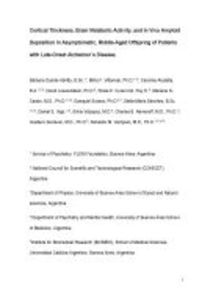Por favor, use este identificador para citar o enlazar este ítem:
https://repositorio.uca.edu.ar/handle/123456789/1461| Título: | Cortical thickness, brain metabolic activity, and in vivo amyloid deposition in asymptomatic, middle-aged offspring of patients with late-onset Alzheimer's disease | Autor: | Duarte-Abritta, Bárbara Villareal, Mirta F. Abulafia, Carolina Andrea Loewenstein, David A. Curiel-Cid, Rosie Castro, Mariana N. Surace, Ezequiel Sánchez, Stella M. Vigo, Daniel Eduardo Vázquez, Silvia Nemeroff, Charles B. Sevlever, Gustavo Guinjoan, Salvador M. |
Palabras clave: | MEDICINA; ENFERMEDAD DE ALZHEIMER; CEREBRO; BIOMEDICINA | Fecha de publicación: | 2018 | Editorial: | Elsevier | Cita: | Duarte-Abritta, B., et. al. Cortical thickness, brain metabolic activity, and in vivo amyloid deposition in asymptomatic, middle-aged offspring of patients with late-onset Alzheimer's disease [en línea]. Postprint del artículo publicado en Journal of Psychiatric Research. 2018, 107. doi:10.1016/j.jpsychires.2018.10.008. Disponible en: https://repositorio.uca.edu.ar/handle/123456789/1461 | Resumen: | Abstract: The natural history of preclinical late-onset Alzheimer's disease (LOAD) remains obscure and has received less attention than that of early-onset AD (EOAD), in spite of accounting for more than 99% of cases of AD. With the purpose of detecting early structural and functional traits associated with the disorder, we sought to characterize cortical thickness and subcortical grey matter volume, cerebral metabolism, and amyloid deposition in persons at risk for LOAD in comparison with a similar group without family history of AD. We obtained 3T T1 images for gray matter volume, FDG-PET to evaluate regional cerebral metabolism, and PET-PiB to detect fibrillar amyloid deposition in 30 middle-aged, asymptomatic, cognitively normal individuals with one parent diagnosed with LOAD (O-LOAD), and 25 comparable controls (CS) without family history of neurodegenerative disorders (CS). We observed isocortical thinning in AD-relevant areas including posterior cingulate, precuneus, and areas of the prefrontal and temporoparietal cortex in O-LOAD. Unexpectedly, this group displayed increased cerebral metabolism, in some cases overlapping with the areas of cortical thinning, and no differences in bilateral hippocampal volume and hippocampal metabolism. Given the importance of age in this sample of individuals potentially developing early AD-related changes, we controlled results for age and observed that most differences in cortical thickness and metabolism became nonsignificant; however, greater deposition of β-amyloid was observed in the right hemisphere including temporoparietal cortex, postcentral gyrus, fusiform inferior and middle temporal and lingual gyri. If replicated, the present observations of morphological, metabolic, and amyloid changes in cognitively normal persons with family history of LOAD may bear important implications for the definition of very early phenotypes of this disorder. | URI: | https://repositorio.uca.edu.ar/handle/123456789/1461 | ISSN: | 0022-3956 | Disciplina: | MEDICINA | DOI: | 10.1016/j.jpsychires.2018.10.008 | Derechos: | Acceso Abierto. 1 año de embargo | Fuente: | Postprint del artículo publicado en Journal of Psychiatric Research, Vol. 107, 2018 |
| Aparece en las colecciones: | Artículos |
Ficheros en este ítem:
| Fichero | Descripción | Tamaño | Formato | |
|---|---|---|---|---|
| cortical-thickness-brain-metabolic.pdf | 721,71 kB | Adobe PDF | Visualizar/Abrir | |
| cortical-thickness-brain-metabolic.jpg | 4,31 kB | JPEG |  Visualizar/Abrir |
Visualizaciones de página(s)
156
comprobado en 30-abr-2024
Descarga(s)
358
comprobado en 30-abr-2024
Google ScholarTM
Ver en Google Scholar
Altmetric
Altmetric
Este ítem está sujeto a una Licencia Creative Commons

